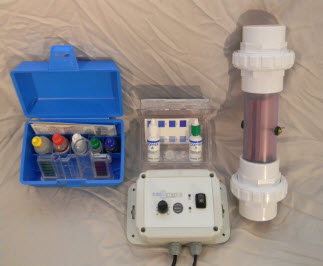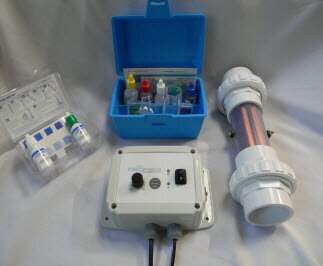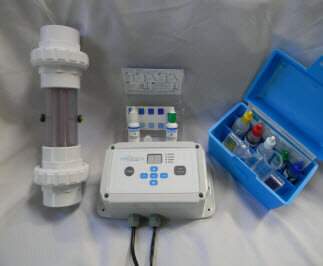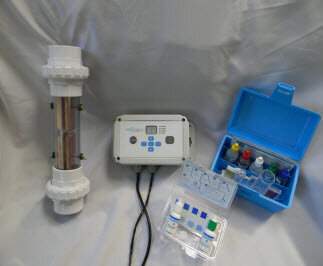Swimming pool sanitation is an important requirement for any pool owner. It is performed to ensure the quality of water as well as to help users from contracting any infectious waterborne diseases. Today, there are various pool sanitation systems available in the market and most swimming pool owners are confused about their options. Among them are several chemical and non-chemical options. Chlorine has been one of the most popular disinfectants used for sanitization. Although it is proven to kill harmful pathogens, there is a growing concern of how prolonged exposure can be harmful pool users. This is why healthier alternatives to chlorine for swimming pools have gained demand in the recent years. Intec America is one of the leading providers of healthy swimming pool sanitation systems in the US. The company has been helping its clients transition to chlorine-free pools saving them time and money without the use of algaecides, chlorine, cyanuric acid, and other pool maintenance chemicals.
Popular Chemical Options for Swimming Pool Sanitation
Over the years, swimming pool and spa owners have utilized the following chemicals for sanitation.
- Chlorine: This has been one of the most widely used chemicals used for swimming pool sanitation. There are various compounds of chlorine used in swimming pools. They include sodium hypochlorite (bleach), calcium hypochlorite, lithium hypochlorite, trichlor, and dichlor. Of these, sodium hypochlorite (bleach), calcium hypochlorite, and lithium hypochlorite are not stabilized; which means they will quickly dissipate out of the swimming pool on exposure to sunlight. However, trichlor and dichlor are stabilized with UV protection compounds such as cyanuric acid. These compounds are known to extend the active residual half-life of chlorine compounds.
Chlorine variants have a residual effect, and they continue to neutralize contaminants as long as their traces exist in water. The following disadvantages of chlorine sanitization increased the demand for safer and healthier swimming pool sanitizers:
- Chlorine byproducts such as trihalomethanes (THMs) and chloramines are known to cause serious side effects such as eye and skin irritation, as well as breathing problems.
- Long-term exposure to chlorine byproducts is believed to lead to heart disease, respiratory problems as well as different forms of cancers.
- As said before, many variants of chlorine break down and dissipate quickly on being added to the swimming pool, so it becomes important to regularly test these pools for the effect of sanitation.
- Chloramines are known to produce unpleasant odor in the pool settings.
- Bromine: Like chlorine, bromine is also a halogen compound, and is widely used for swimming pool sanitization in warmer temperatures. Bromine is being used since 1936 to treat pool water. This usage gained popularity during the World War II due to chlorine scarcity.
Chloramines (from chlorine) and bromamines (from bromine) are byproducts which are formed when they combine with ammonia in the pool water. Ammonia can enter the pool via sweat, mucus, urine, and perspiration. Both are known to have various side effects and they offer no benefits to pool water. Bromamines are known to effect sanitation even when all pool / spa chemical levels are withing an acceptable range and may require more frequent shock treatments. Being oxidizers, chlorine and bromine pools both will require periodic shock treatments as the active ingredient will combine with organics and biologicals which must be removed.
Another point of difference between bromine and chlorine is their residual effect. It is difficult to stabilize bromine and the UV rays from the sun will shorten its effective life. Bromine, however, does have the advantage to work in a greater temperature range as well as a greater pH range.
Like chlorine, bromine also has certain disadvantages, which makes it a less favorable option for disinfection. The following are a few disadvantages of bromine:
- Bromine produces a pungent smell, which is hard to wash away from the skin after using a bromine spa or pool.
- Bromine is a reactive compound, so it demands immense care during transportation, storage, and usage.
- A satisfactory level of disinfection can be achieved only when bromine is used in high quantities and bromamine levels are minimal.
- Hypobromous acid and bromamines are known to offer effective sanitization, but they can be harmful to human health.
- Chlorine-Free Pool Chemicals: Aqua Silk®, Baquacil®, and Softswim® are a few popular chlorine free pool chemicals available in the market today. These chemicals comprise polyhexamethylenebiguanide (PHMB), which serves as the active ingredient. There are several advantages of PHMB over chlorine which makes them attractive. PHMB is not an oxidizer and remains unaffected by sunlight making their residuals more stable in pools and spas.
PristineBlue® has an active ingredient of copper sulfate pentahydrate. Copper is a very effective algaecide. Like the aforementioned products, it is not an oxidizer so you will need periodic shock. The problem is that anything that you need to maintain the pool, you should stick with its complementary and proprietary products.
These chemicals also offer certain disadvantages, which makes them a weaker option when compared to other swimming pool disinfection methods. These disadvantages include:
- None of these are oxidizers, so it may require a shock treatment for clarity. Normally, 27% hydrogen peroxide shock treatment is administered.
- PHMB based products are quite expensive and they require high maintenance when used for disinfection.
- PristineBlue® can stain pool surfaces if the chemistry is not in balance.
- PristineBlue® is probably the most expensive of all to maintain.
- Not all stores carry these products so one may spend a lot on gas trying to locate them.
Owing to the side effects of chemicals and chlorine, swimming pool users are nowadays opting for non-chemical, less-expensive alternatives to pool chemicals.
Popular Non-Chemical Alternatives to Chlorine for Swimming Pools
The following are a few non-chemical treatments for swimming pools:
- Ionizers: Ionization has been around for a long time. There has been a bit of advancement in the technology in recent years. Ionization is a process, where a current is supplied from an external ionizer controller to a sacrificial electrode made from pure metals or alloys such as copper/silver, copper, and copper/zinc. As the electrode is in direct contact with water, the water acts as a conductor allowing the metallic ions to be released through the process of electrolysis. These ions disturb the enzyme balance by piercing through the protective membrane in bacteria and algae cells. The ions also stop oxygen and gas intake, which affects the growth of the cells and ultimately kills them. These ionizers are totally safe for humans.
- Mineralizers: These low chlorine alternatives have been used for a long time. They use minerals packaged in a cartridge that water flows through and deactivates many microorganisms. These minerals are usually comprised of copper, zinc, and even silver. The non-electric reaction of the dissimilar metals can increase oxygen to your swimming pool making it less favorable for many microorganisms. These metals also act as a bacteriostat and algaestat to stunt biological growth as water flows through the cartridge. Although these minerals work together to kill bacteria and algae, they only reduce the chlorine dependence as no sanitation residual is produced. They are often used with chlorine or bromine the for best results.
- Ozonation: Ozone is created during the collision of free oxygen atoms and molecules. This collision is artificially created by subjecting oxygen molecules to ultraviolet radiation or high-voltage ionization process. Most ozone generators utilize high-voltage ionization because it produces ozone in high concentrations. Ozone is considered to be faster acting and destroys a wider range of microorganisms than chlorine. It is also effective in in oxidizing chloramines. Ozone gas generators such as the DEL Ozone SEC 100-26 Solar Eclipse has introduced a new plasma gap technology, which produces high amount of ozone and hydroxyl radicals. However, it has also quite expensive compared to other ozone generators used for swimming pools. Although ozone has emerged as one of the key water disinfection technologies, there are certain drawbacks. It has a very short half-life, and it cannot serve as a sufficient sanitization method on its own. Ozone sanitized pools still require additional sanitation methods such as chlorine, bromine, or ionization. However, the frequency of shock treatments is greatly reduced.
- U/V Light: UV sanitation utilizes short-wavelength UV light to kill microorganisms. The light can destroy viruses, cysts, or protozoa. It also kills the chlorine-resistant bacteria. UV radiation is produced through a quartz sleeve fitted with a UV bulb. Sanitation takes place inside the quartz sleeve, where the running water is induced and runs parallel to the UV bulb. However, over time, calcium will scale over the quartz sleeve, and make it ineffective. This is also one concept that Intec does not endorse for the swimming pool sanitization market. Although we have been providing U/V light sanitizers for a while for POE home and commercial use, we do not believe the cost of such a technology offers enough benefit for a swimming pool unless one is trying to control chloramines for an indoor applications.
Copper Ionization Vs Salt Water Pools
Salt Water Chlorine Generators (SWG) have emerged as one of the popular alternatives for swimming pool sanitization in recent years. There are still many consumers that believe it is the saltwater and not the SWG produced chlorine that acts as the disinfectant. Chlorine is produced through electrolysis and uses the added salt (sodium chloride) to form hypochlorous acid (which as a sanitizer) and hydroxyl ions (oxidant or filter aid). This is essentially the same chemical combination produced using household bleach.
Newer Salt Water Chlorine Generators have the option to boost chlorine levels in greater concentrations, which makes the swimming pool super chlorinated. This super chlorination is known to tackle the production of chloramines. On the downside, improper maintenance, faulty sensors, or chemical imbalance can cause any SWG pool to become super chlorinated which can damage equipment, pool surfaces, and become dangerous for swimming.
Salt chlorine generators has gained immense attention due to many misconceptions. Some common misconceptions are: they have a stabilizing effect on pools, and one need not worry about pH levels; one-size system works for all pools; and they require no or minimal maintenance. However, none of this is true. The following points will help you understand it better:
- Corrosion: In salt water pools, airborne saltwater and salt spray will introduce chloride ions into the environment. When combined with moisture and high temperatures, these chloride ions may initiate a corrosion process which may affect any type of metal. Excessive salt chlorination offered by these systems are known to contribute to breakdown of lighting systems, handrails of swimming pools, bleaching of swimming pool liners, and corrosion swimming pool decks.
- Degrading of Coping: The salt produced by the salt water pool will damage or attack the cement, plaster, and coping of the pool. There is a common misconception that unbalanced water chemistry may serve as a breeding ground for algae. To avoid this, many swimming pool owners end up over chlorinating their pools. When the salt water hits coping, it leaves behind pure salt, which percolates into the coping and initiates corrosion. This demands for sealing of the coping, or cleaning the coping with fresh water every day before swimming. Generally, this cleaning is performed using a fresh water hose.
Due to all these problems, nowadays many pool builders refuse to build salt water swimming pools with taupe or cream limestone coping. They also require swimming pool owners to sign a release form. - Harmful to the Environment: As mentioned before, the high salt concentration found in the salt water pools may affect grass, planters, trees, and shrubs near the pool. In most cases, after heavy rains the water seeps underneath the coping and enters into the yard. This may affect the landscaping. The maintenance or replacement of landscaping can be very expensive. Salt water is also proven to be hazardous to pets, and may lead to dehydration, when your pets consume it accidently. Some counties require cartridge filters to be used with SWGs as the municipality cannot remove the high salt discharge which can be damaging to wetlands.
- Difficulties in Maintaining and Balancing Water Chemistry: Maintaining a healthy swimming pool water chemistry is a challenging task for swimming pool owners. This water chemistry may be affected due to varying reasons such as swimmers, sunlight, pool filters, and so on. Most treatment systems fail to respond when salinity is unbalanced. When the salt levels are too low, the production of chlorine is not possible. If too much salt is added, the increased salinity may affect stabilizers and chemicals, thereby causing even more damage to your pool.
- Increased pH issues: Hydroxl radicals (OH–) are produced during the electrolysis process. This causes continuous rise in the pH values and makes the chlorine less effective as a disinfectant. To balance the pH values, other treatment methods are initiated.
However, copper ionizers provide a healthier swimming pool choices than the above-discussed points. The following benefits make them an ideal choice in all environments:
- The copper pool ionizers are compatible with almost all types of filters available in the market, and they can be retrofitted to any pool.
- Copper ions produce no harmful byproducts and offer lasting residual protection to pool water.
- Copper ions are safer for people of all ages, and they cause no harm to the environment.
- The copper ions in pools are not affected by temperatures changes nor UV rays from the sun.
- Ionized pools are easy to maintain and can be easily balanced.
- Being pH neutral, these ionized pools are easy to maintain unlike chlorinated and salt water pools.
To have a detailed discussion on swimming pool ionization capabilities of Intec America, please get in touch with our experts today.






